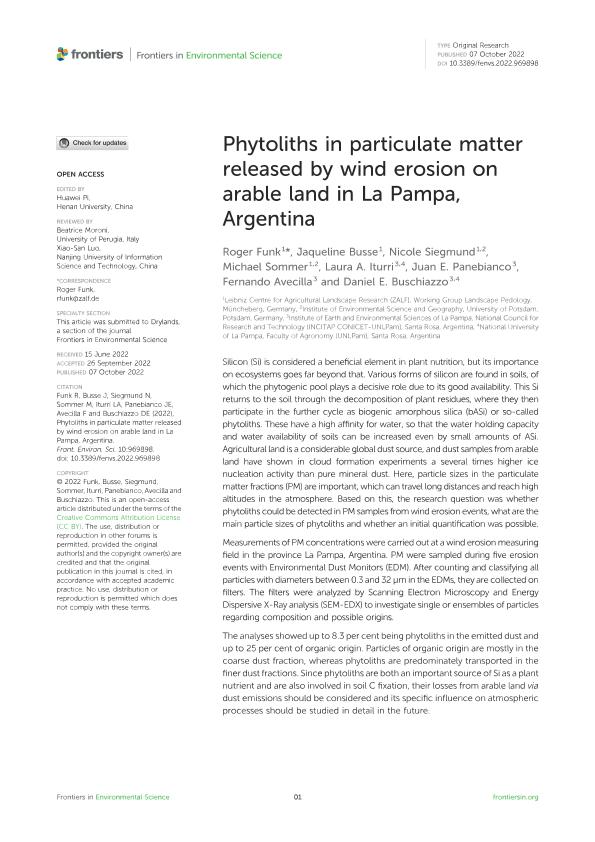Mostrar el registro sencillo del ítem
dc.contributor.author
Funk, Roger
dc.contributor.author
Busse, Jaqueline
dc.contributor.author
Siegmund, Nicole
dc.contributor.author
Sommer, Michael
dc.contributor.author
Iturri, Laura Antonela

dc.contributor.author
Panebianco, Juan Esteban

dc.contributor.author
Avecilla, Fernando

dc.contributor.author
Buschiazzo, Daniel Eduardo

dc.date.available
2023-09-27T14:19:09Z
dc.date.issued
2022-09
dc.identifier.citation
Funk, Roger; Busse, Jaqueline; Siegmund, Nicole; Sommer, Michael; Iturri, Laura Antonela; et al.; Phytoliths in particulate matter released by wind erosion on arable land in La Pampa, Argentina; Frontiers Media; Frontiers in Environmental Science; 10; 9-2022; 1-10
dc.identifier.issn
2296-665X
dc.identifier.uri
http://hdl.handle.net/11336/213203
dc.description.abstract
Silicon (Si) is considered a beneficial element in plant nutrition, but its importance on ecosystems goes far beyond that. Various forms of silicon are found in soils, of which the phytogenic pool plays a decisive role due to its good availability. This Si returns to the soil through the decomposition of plant residues, where they then participate in the further cycle as biogenic amorphous silica (bASi) or so-called phytoliths. These have a high affinity for water, so that the water holding capacity and water availability of soils can be increased even by small amounts of ASi. Agricultural land is a considerable global dust source, and dust samples from arable land have shown in cloud formation experiments a several times higher ice nucleation activity than pure mineral dust. Here, particle sizes in the particulate matter fractions (PM) are important, which can travel long distances and reach high altitudes in the atmosphere. Based on this, the research question was whether phytoliths could be detected in PM samples from wind erosion events, what are the main particle sizes of phytoliths and whether an initial quantification was possible. Measurements of PM concentrations were carried out at a wind erosion measuring field in the province La Pampa, Argentina. PM were sampled during five erosion events with Environmental Dust Monitors (EDM). After counting and classifying all particles with diameters between 0.3 and 32 µm in the EDMs, they are collected on filters. The filters were analyzed by Scanning Electron Microscopy and Energy Dispersive X-Ray analysis (SEM-EDX) to investigate single or ensembles of particles regarding composition and possible origins. The analyses showed up to 8.3 per cent being phytoliths in the emitted dust and up to 25 per cent of organic origin. Particles of organic origin are mostly in the coarse dust fraction, whereas phytoliths are predominately transported in the finer dust fractions. Since phytoliths are both an important source of Si as a plant nutrient and are also involved in soil C fixation, their losses from arable land via dust emissions should be considered and its specific influence on atmospheric processes should be studied in detail in the future.
dc.format
application/pdf
dc.language.iso
eng
dc.publisher
Frontiers Media

dc.rights
info:eu-repo/semantics/openAccess
dc.rights.uri
https://creativecommons.org/licenses/by-nc-sa/2.5/ar/
dc.subject
DUST
dc.subject
DUST COMPOSITION
dc.subject
PARTICULATE MATTER
dc.subject
PHYTOLITH
dc.subject
SCANNING ELECTRON MICROSCOPE (SEM) ANALYSIS
dc.subject.classification
Otras Ciencias de la Tierra y relacionadas con el Medio Ambiente

dc.subject.classification
Ciencias de la Tierra y relacionadas con el Medio Ambiente

dc.subject.classification
CIENCIAS NATURALES Y EXACTAS

dc.title
Phytoliths in particulate matter released by wind erosion on arable land in La Pampa, Argentina
dc.type
info:eu-repo/semantics/article
dc.type
info:ar-repo/semantics/artículo
dc.type
info:eu-repo/semantics/publishedVersion
dc.date.updated
2023-07-05T15:20:05Z
dc.journal.volume
10
dc.journal.pagination
1-10
dc.journal.pais
Suiza

dc.description.fil
Fil: Funk, Roger. Leibniz-zentrum Für Agrarlandschaftsforschung; Alemania
dc.description.fil
Fil: Busse, Jaqueline. Leibniz-zentrum Für Agrarlandschaftsforschung; Alemania
dc.description.fil
Fil: Siegmund, Nicole. Universitat Potsdam; Alemania. Leibniz-zentrum Für Agrarlandschaftsforschung; Alemania
dc.description.fil
Fil: Sommer, Michael. Leibniz-zentrum Für Agrarlandschaftsforschung; Alemania
dc.description.fil
Fil: Iturri, Laura Antonela. Consejo Nacional de Investigaciones Científicas y Técnicas. Instituto de Ciencias de la Tierra y Ambientales de La Pampa. Universidad Nacional de La Pampa. Facultad de Ciencias Exactas y Naturales. Instituto de Ciencias de la Tierra y Ambientales de La Pampa; Argentina
dc.description.fil
Fil: Panebianco, Juan Esteban. Consejo Nacional de Investigaciones Científicas y Técnicas. Instituto de Ciencias de la Tierra y Ambientales de La Pampa. Universidad Nacional de La Pampa. Facultad de Ciencias Exactas y Naturales. Instituto de Ciencias de la Tierra y Ambientales de La Pampa; Argentina
dc.description.fil
Fil: Avecilla, Fernando. Consejo Nacional de Investigaciones Científicas y Técnicas. Instituto de Ciencias de la Tierra y Ambientales de La Pampa. Universidad Nacional de La Pampa. Facultad de Ciencias Exactas y Naturales. Instituto de Ciencias de la Tierra y Ambientales de La Pampa; Argentina
dc.description.fil
Fil: Buschiazzo, Daniel Eduardo. Consejo Nacional de Investigaciones Científicas y Técnicas. Instituto de Ciencias de la Tierra y Ambientales de La Pampa. Universidad Nacional de La Pampa. Facultad de Ciencias Exactas y Naturales. Instituto de Ciencias de la Tierra y Ambientales de La Pampa; Argentina
dc.journal.title
Frontiers in Environmental Science
dc.relation.alternativeid
info:eu-repo/semantics/altIdentifier/doi/https://doi.org/10.3389/fenvs.2022.969898
Archivos asociados
